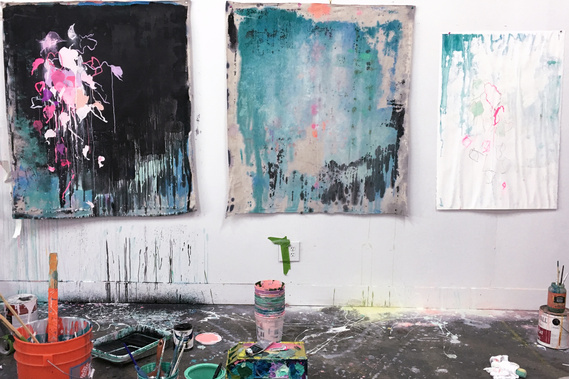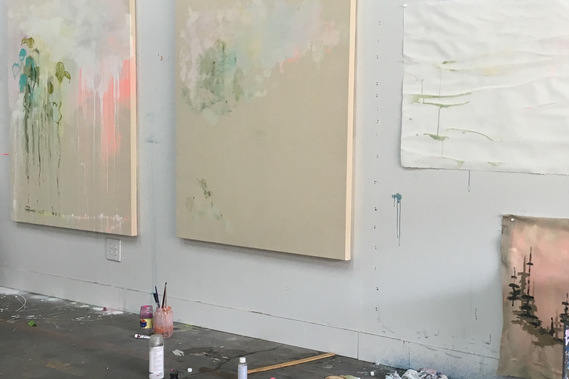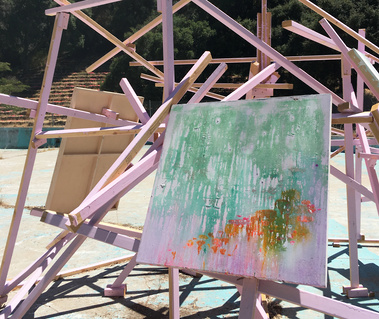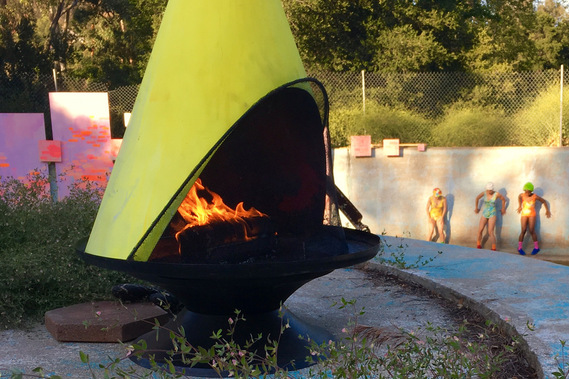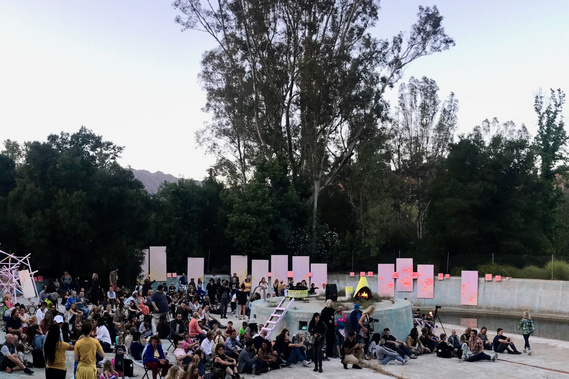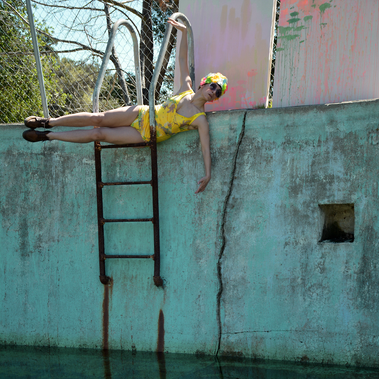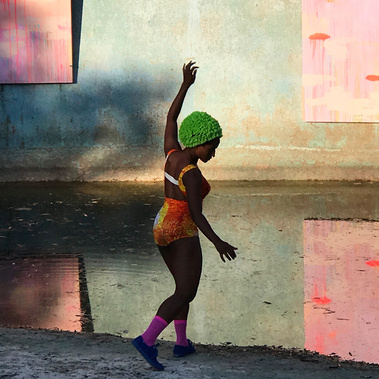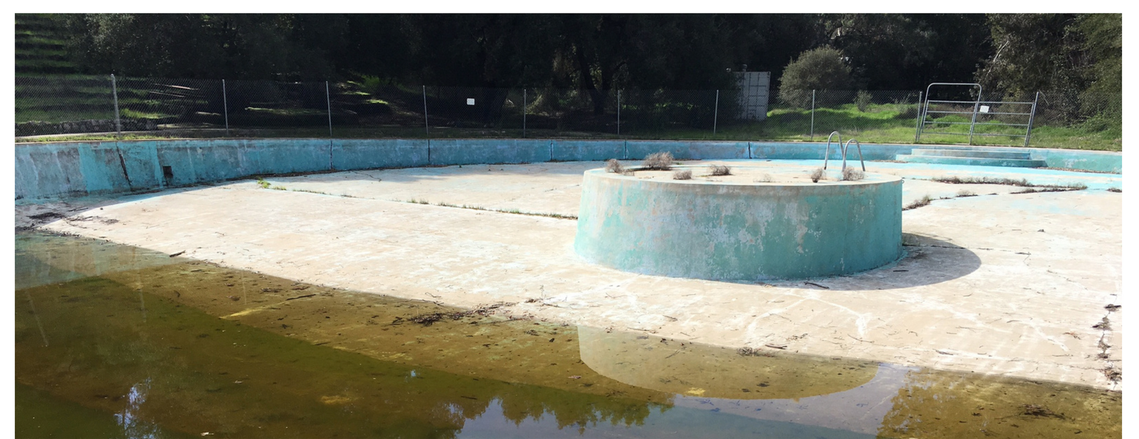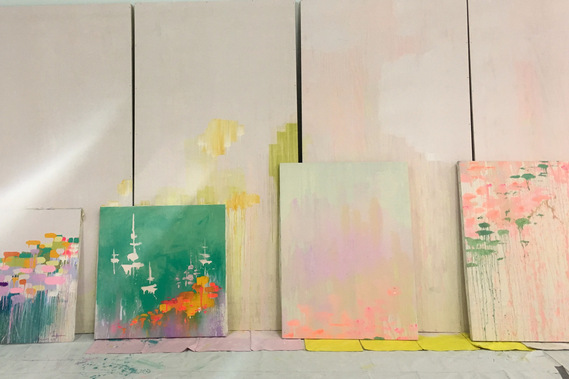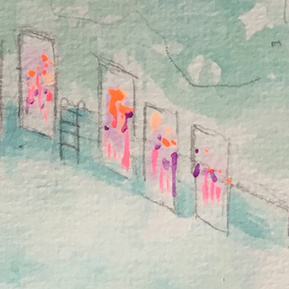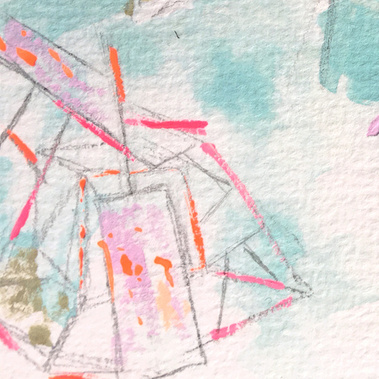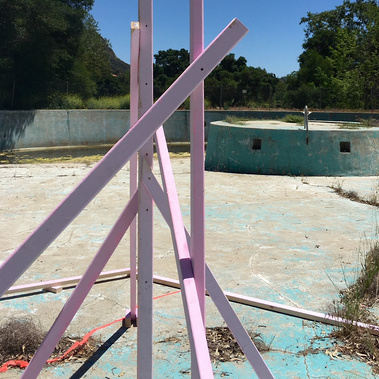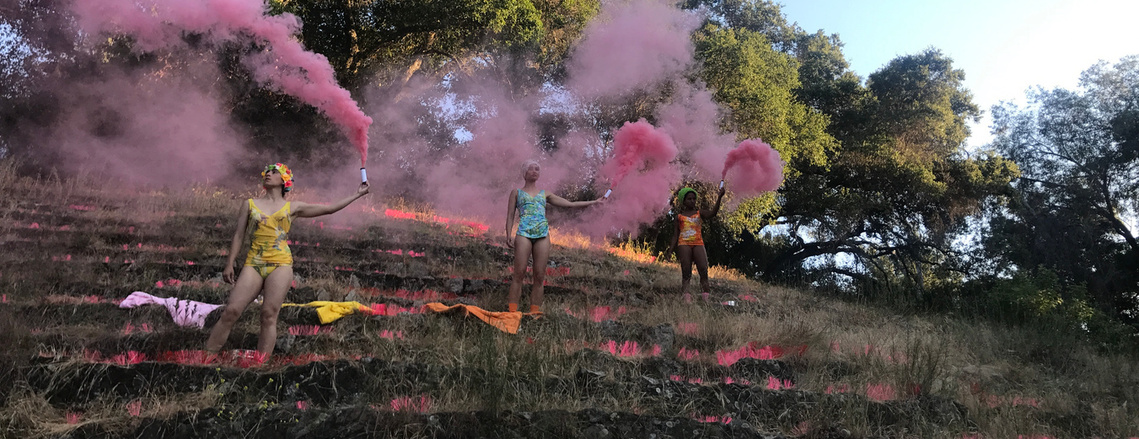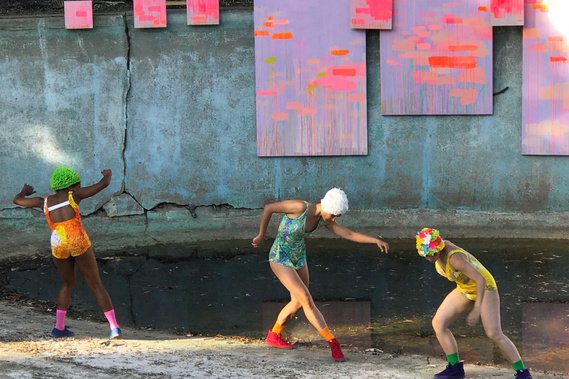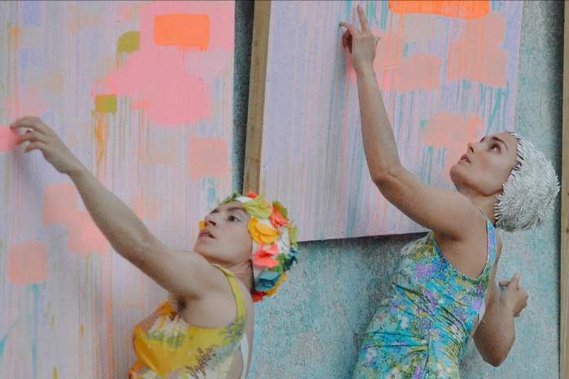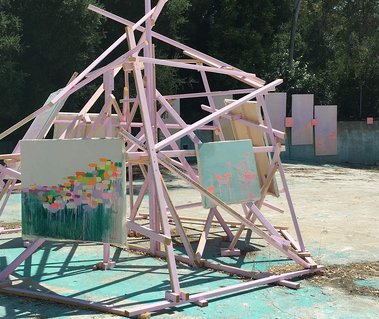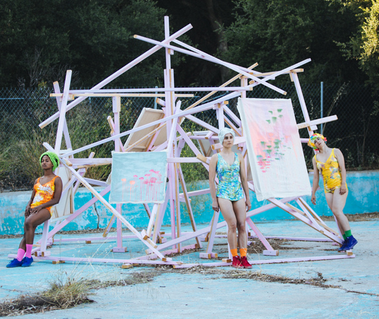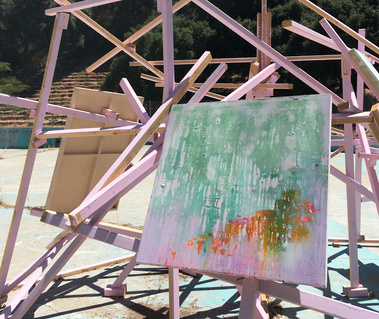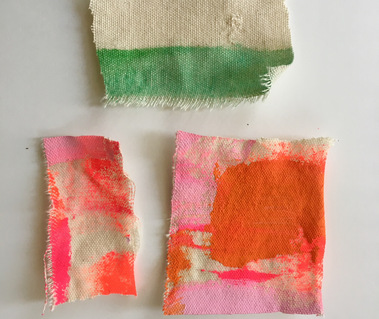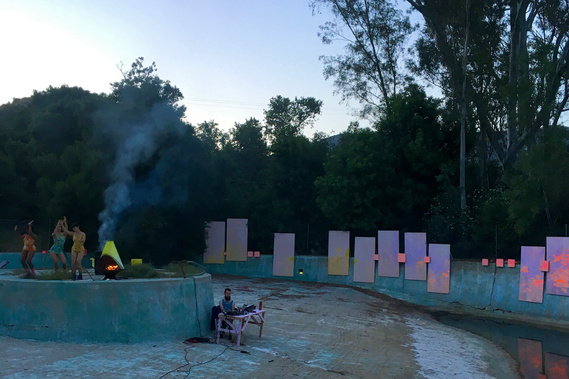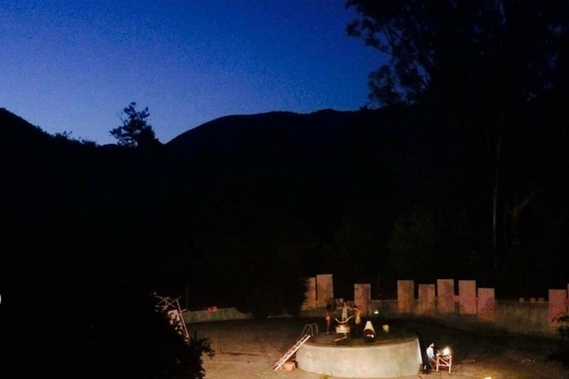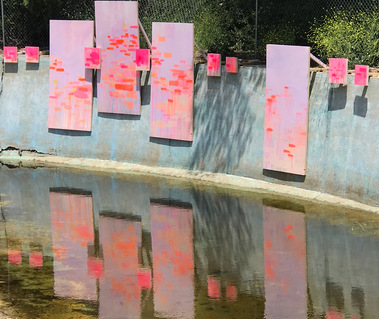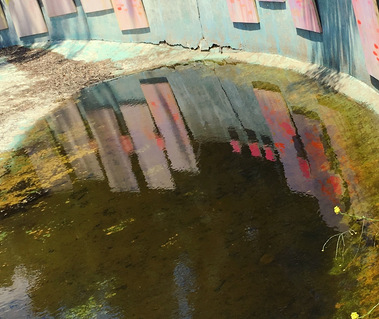KiM WEST
LAKE ENCHANTO, 2017
Peter Strauss Ranch, Santa Monica Mountains
A washy, gestural, fractured 115+ foot mural. Five layer paintings attached to a pale pink, wooden play structure easel. A color stained ladder, painted fire pits, and glowy light elements. A project about memory, loss, and layers. This is the work that was installed in the empty and beautifully decaying 650,000 gallon pool at Peter Strauss Ranch, and that was activated with a one-night, site-specific collaborative performance by Heidi Duckler Dance Theatre and sound artist Davy Sumner.
LAYER PAINTINGS
Layer paintings formed the context for the eventual performance element of LAKE ENCHANTO:
Sometime in 2015, I became interested in capturing physical imprints from the process of making paintings, especially paintings that were themselves inspired by memories. I refer to these works as layer paintings. In layer paintings, canvas is placed directly on top of canvas, on top of paper, on top of wood - or in some combination there-of. Marks and gestures made on the top layer painting bleed, soak, and stain into whatever is beneath. When an initial top layer painting is finished, I peel it back to see what remains, and this reveals new work. Memories of the physical creation of paintings are captured, documented, and preserved.
Memories of memories of memories: The way an event, a person or people, a conversation, an object, or an experience can each seem indelible, but then time passes and rolls over, and it changes. Acceptance and pain can go hand in hand when a clear memory grows fuzzy. Physical objects can assume disproportionate importance when the people emotionally connected to those objects are no longer tangible. Memories become sacred souvenirs, and sentimental objects are buoys that triangulate their drift.
As the layer paintings became more and more about what marks, imprints, or stains remained, they seemed to reflect the grasping at ether (for image, for meaning) that begins to happen when memories haze around the edges. In the logic of this reflection cycle, an obvious, inescapable conclusion for me was that some top layer paintings should cease to exist, and instead only show up in the remnants captured from the making of the paintings themselves.
HEIDI
A year or so before I began working with layer paintings, I'd had a conversation with Heidi Duckler, founder of Heidi Duckler Dance Theatre. Heidi had seen my mural work and reached out, wondering if we might collaborate in some way. Heidi's work is immersive, improvisational, and evocative. It demands something of the audience. I was intimidated especially by that last part, and unsure of how my work might fit into her audaciously extroverted world.
I am not a performer, and, felt compelled by the idea of an experience centered around the concept of performatively revealing the palimpsest of layer paintings, beyond what a video or film alone might convey to an audience. Original paintings displayed, under paintings eventually revealed, and, original paintings destroyed – burned in a funerary act – leaving the viewer with only memories, or other simulacra, of the initial work. That narrative arc seemed powerful and inevitable. I did not feel comfortable commanding an audience, but a participatory, witnessing element seemed like an important part of the work.
Thinking the performative process of revealing a layer painting was an idea that Heidi might be interested in developing together, I invited her over for a studio visit. We looked at the layer paintings, and talked about the weather.
In 2016, LA had been in extreme drought for a few years, and in that literal climate, pitching a project collaboration that involved the burning of yards of painted canvas pyre style seemed possibly off-putting, possibly dangerous, and certainly somewhat foolish. Heidi asked if I knew about the abandoned pool at Peter Strauss Ranch in Agora Hills.
THE SITE
Peter Strauss Ranch is a National Parks Service site in Santa Monica Mountains National Recreation Area, in Agoura Hills, California.
An oak woodland with terraced hillsides, the site was once home to 'Lake Enchanto', a pre-Disney World recreation destination. From 1945-55, 'Lake Enchanto' was a charming fairyland, boasting a 650,000 gallon pool with a center platform stage, a large aviary, an amphitheater, a terrazzo dance floor, expansive lawns, and meandering trails through oaks, chaparral, and alongside a creek.
In 2003, Los Angeles Times staff writer Bob Pool wrote about the site's history, including its connections to the Indy 500, the Manson family, canyon hippies, Watergate, buried treasure, and movie stars: "Nearby, they built a 125-foot-wide, 650,000-gallon oval swimming pool. With a capacity of 3,000 swimmers, it was touted as the largest pool west of the Rockies. A platform-like island in the center was reached by boat and served as a stage for musicians who entertained crowds of up to 5,000 that watched from benches carved into a hillside above the pool." - Bob Pool
Much of the infrastructure was destroyed by the Woolsey fire in 2018, but the pool remains.
INSTALLATION ELEMENTS
Heidi and I went out to visit the pool together, and the pieces to logistically develop this project fell into place quickly thereafter. I returned to the pool often, to explore and familiarize myself with the site, to think more about how the project could best be shared with an audience, and how the work might sit with the space.
Over the span of several more months in studio, I made five layer paintings and 45 panels that would make up elements of the installation.
Part of my practice, especially at the beginning of projects, often includes the meditative and meandering process of creating watercolor documentations of myriad relevant details. Painting these kinds of studies is a way for me to better understand and absorb the things that I notice, and imprint them on memory. The process also creates a space between the original thing and my interperatation of it, allowing me to better internalize the imagery and create a new vocabulary from it.
Bathing suits and caps for the performance were inspired by a collection of swimwear I inherited from my Grandmother's closet. I sourced similar vintage pieces, and these were tailored to fit each performer.
I wanted the installed mural panels to float above and dip into the pool, and pop up from the deck ledge in a meandering, playful cadence. Nothing could be affixed to any part of the pool's surfaces, and, the panel installations needed to be sturdy enough to withstand the significant natural wind conditions of the canyon area. I envisioned building mural panel support structures onsite with a simple construction employing gravity, friction, and 2x4s. The slight angle of the pool walls worked to help lock the panels in place.
The play structure easel too was built onsite. A support for the layer paintings, the structure also functioned as a visual element to punctuate the horizontal linearity of the mural. When top layer paintings are created, the applied paint can act as a glue to the bottom substrate. The dancers would need to aggressively remove the painted canvas fabric in order to reveal the bottom layers, so the whole apparatus had to withstand the pressure of that process, as well as support the climbing performers.
THE PERFORMANCE
At sunset on Saturday, June 3rd, 2017, the installation was activated and permanently altered with shears and flames in a one night only collaborative and site-specific performance by Heidi Duckler Dance Theatre and experimental sound artist Davy Sumner.
From the pool’s adjacent terraced hillside, three dancers from the Heidi Duckler Dance Theatre, Toogie Barcelo, Haylee Nichele, and Himerria Wortham, descended in billows of color dressed in vintage bathing suits and caps. Prior to the performance, the hillside had been serendipitously installed with hundreds of hot pink construction markers in Olg Lah's Bloom project.
As the dancers entered and moved throughout the space, their choreography guided the audience along an activating exploration of the pool’s surfaces, sundial-style, around the crater’s center platform. Floaty sounds tinkled in from sound artist Davy Sumner’s amplification of nature noises, old-time-pool-side-music, and sonically manipulated physical elements of the pool itself.
In inevitable conclusion, the performers addressed the climbing play structure and peeled back the attached layer paintings, revealing the under-work. They also cut, ripped and tore. Some work was rendered into fragmented forms, and those pieces became mementos that were distributed to the audience as souvenirs. Other parts of the top-layer original paintings were delivered into platform fire pits, where the canvases were burned, and dancers tended flames and formed a ritualistic pyre.
The performance was free and open to the public. The altered installation remained on site and open to the public during park hours through September, 2018. Various community workshops, including a ghost-printmaking workshop, were held onsite throughout the project's residency.
LAKE ENCHANTO was proposed as a site-specific project for Arts in the Parks program at the Peter Strauss Ranch in the Santa Monica Mountains National Recreation Area, a unit of the National Park Service, was supported in part with an award from the Santa Monica Mountains Fund, was reviewed by art critic Shana Nys Dambrot, and the subject of a short film by Ben Dolenc.


